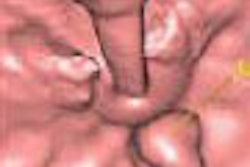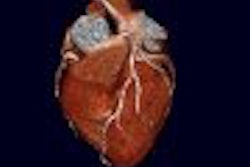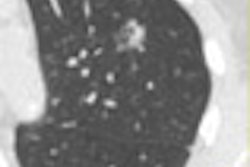A Canadian lung cancer screening study has found, once again, that thin-section CT screening identifies small resectable lung cancers in time to potentially cure the disease.
Researchers from the University of Toronto in Canada participated as an International Early Lung Cancer Action Plan (I-ELCAP) trial center, and used ELCAP criteria to guide follow-up and intervention of their cohort of smokers and former smokers.
Indeed the Canadian results -- a 2.2% malignancy rate and 78% presenting with early-stage disease -- were quite similar to those of previous ELCAP efforts, led by Dr. Claudia Henschke and her team from New York City's Weill Medical College of Cornell University and New York-Presbyterian Hospital.
"Issues related to screening for lung cancer in Canada are both similar to and different from those in other countries," wrote study authors Drs. Heidi Roberts, Demetris Patsios, Narinder Paul, and colleagues from the University of Toronto (Canadian Association of Radiologists Journal, October 2007, Vol. 58:4, pp. 225-235).
In Canada, lung cancer is the leading cause of death for both men and women, and its incidence "is not expected to decrease considerably in the near future because more than 10% of the Canadian population currently smokes, and because former smokers appear to remain at risk for lung cancer even decades after stopping smoking," they wrote.
As in the U.S., CT lung cancer screening is neither recommended nor paid for by healthcare providers in Canada; a private donation to Princess Margaret Hospital in Toronto was required to fund the program, the study team noted.
Toronto study
Between 2003 and 2005, the group enrolled 1,000 high-risk smokers or former smokers age 55 and older (mean age 63 years, S.D. eight years) with a history of at least 10 pack years (a pack a day smoked for 10 years), but no history of cancer. In all, 662 (66%) were former smokers and 338 (34%) were current smokers, and mean smoking history for the mostly self-referred volunteer cohort was 38 pack years.
All participants underwent low-dose baseline screening with multidetector-row CT on several scanner models (four- to 64-slices) from GE Healthcare of Chalfont St. Giles, U.K.; Toshiba America Medical Systems of Tustin, CA; and Siemens Medical Solutions of Malvern, PA. Imaging was performed using thin-slice acquisition using 40-60 mAs, 120 kVp, collimation of 1.0-2.5 mm, and axial reconstructions of 1-1.25 mm.
Follow-up of positive findings per ELCAP guidelines "eventually led to a rule-in diagnosis of lung cancer," Roberts and her colleagues explained. A positive finding at baseline included at least one solid or part-solid noncalcified nodule (NCN) 5 mm or larger, or at least one nonsolid NCN 8 mm or larger.
"In brief, nonsolid or part-solid nodules 15 mm or larger may be biopsied immediately," they wrote of the ELCAP criteria. "Nonsolid or part-solid nodules 15 mm or larger may be followed with a limited (covering the nodule only) thin-slice CT one month after oral antibiotics are initiated, or they may be biopsied (fine-needle aspiration) immediately. Solid nodules 5 mm or larger are followed after three months with a limited thin-slice CT." Nodules smaller than 5 mm are followed up annually.
Baseline positives versus carcinomas
The results revealed 256 (26%) of participants with a positive baseline scan; of these, 227 were followed after three months and 16 (1.6%) after one month, and seven received a contrast-enhanced CT-guided biopsy.
"Two of the seven contrast-enhanced CT scans were performed because of obvious malignancy on the baseline screening scan for staging purposes, and to assess the relation to adjacent vascular structures," they wrote. "The remaining four contrast-enhanced CTs were performed because of incidental findings in the chest, mostly of mediastinal origins." Six biopsies performed immediately after baseline low-dose scanning were all positive.
Of the 227 subjects (416 nodules) rescanned after three months, 58 subjects had nodules that resolved completely or partially, and were therefore referred for annual scans along with 148 subjects whose findings remained unchanged. Ultimately only five of these were diagnosed with cancer. "A large proportion of nodules had been unnecessarily regarded as positive," they wrote. A retrospective reevaluation showed that just over half of these nodules (n = 174, 51%) would have been spared the three-month follow-up.
In all, 26 invasive procedures were performed, including 22 fine-needle aspiration biopsies, one ultrasound-guided lymph-node metastasis biopsy, one bronchoscopic biopsy, and two surgeries. A total of 85% of interventions were positive for cancer.
"Overall, the malignancy prevalence is 2.2%," they wrote. "Of the malignancies, 20 are lung carcinomas: 19 non-small cell lung carcinomas (NSCLCs) (14 adenocarcinomas or bronchoalveolar carcinomas [BACs], four squamous carcinomas, and one large-cell carcinoma) and one small-cell carcinoma."
In all, 12 cancers presented as solid nodules, four were part-solid nodules, and four were nonsolid. The mean number of pack years smoked for participants diagnosed with lung carcinoma was 47. Lung cancers were found in 10 smokers and 10 former smokers.
Fifteen (78%) of the NSCLCs were stage 1 (11 stage 1A and four stage 1B). Three patients (16%) had stage III cancer and one patient (5%) stage IV. Fifteen of the 19 NSCLCs were potentially resectable, but one patient had severe emphysema. Fourteen patients underwent surgery (one pneumonectomy, nine lobectomies, and four segmentectomies); another five received chemotherapy as their primary treatment modality.
A total of 2.6% of screened individuals underwent invasive procedures, compared to the 2.5% ELCAP rate, though other studies have reported higher numbers, up to 17%.
Implications
"We have successfully established a lung cancer screening program using (low-dose CT) within the Canadian health care system and have shown that (low-dose CT) screening detects cancers at an early stage that can be treated with curative intent," the researchers wrote.
They noted they might have considered joining the U.S.-based National Lung Screening Trial (NLST) because it was randomized and the results potentially more meaningful as a result. However, the trial was limited to U.S. centers, and in any case, it was not randomized to CT but rather to chest x-ray, which is known to have a low sensitivity for lung cancers, they stated.
Controversy remains over the validity of nonrandomized CT screening trials of the ELCAP variety, particularly following the release of a March study concluding that CT screening produced no mortality benefit, perhaps owing to the risks of surgery and the effects of statistical bias that make other trials only appear to improve the lot of lung cancer patients who are treated (Journal of the American Medical Association, March 7, 2007, Vol. 297:9, pp. 953-961).
Though randomized studies are under way (including NSLT in the U.S. and ITALUNG in Europe) to settle the question, the inferred benefits of nonrandomized screening remain strong and, as shown in the current study, are apparently reproducible.
"I-ELCAP's goal is to assess the effectiveness of CT screening in preventing deaths from lung cancer," wrote Roberts and colleagues. "This is done by determining the deaths that are prevented by early diagnosis and early treatment after long-term follow-up to determine cure rates. Conversely, randomized trials have mortality as the primary end point. Much evidence in the literature supports the benefit of early diagnosis to increase lung cancer curability; this evidence comes both from incidental reports showing that unresected T1 cancers have high mortality rates, and from publications confirming that small tumors indeed imply early stages and improved survival."
Although the ELCAP flowchart for follow-up and intervention was helpful, not every case fit its algorithm, they noted. "Decisions to proceed to contrast-enhanced CT or to immediate biopsies were based more on the radiologist's experience and clinical judgment ... and the cancer yield was indeed high: 100% of immediate biopsies and almost 30% of contrast-enhanced CTs," they wrote.
While discussions on the use of low-dose CT for screening await the results of randomized trials, "our results endorse the position that lung cancer screening is feasible in a larger single institution, under research conditions, and with ethics supervision," the team concluded.
By Eric Barnes
AuntMinnie.com staff writer
November 13, 2007
Related Reading
Measuring lung nodule growth beyond variability, November 5, 2007
Divergent research on CT lung screening sparks more debate, fewer answers, April 7, 2007
CT screening may not improve lung cancer survival, March 7, 2007
Italung-CT results show efficacy of lung cancer screening, March 9, 2007
Overdiagnosis common in lung cancer screening, February 7, 2007
CT lung cancer screening reduces mortality, October 26, 2006
Copyright © 2007 AuntMinnie.com



















